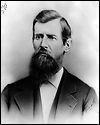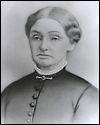 | | TOM REESE / THE SEATTLE TIMES | | To see this headstone of a relative, Low-family descendent Ruth Moore has to visit the display of stones removed from the cemetery by the Snohomish Historical Society and put on display across the street. |
SNOHOMISH — Generations of neglect have transformed an old pioneer cemetery into a pastoral snarl. For much of the past 100 years, trees, bushes and grasses have risen from the ground like wild spirits.
A community center for senior citizens, painted a pretty shade of pink, rests on a corner of the ancient graveyard, placed there 10 years ago to benefit the living. Blacktop was laid for a parking lot, and an addition was built a few years later.
The addition rests atop or near the burial spot of John and Lydia Low. Either way, their descendants view it as a disgrace considering the couple's role in Seattle history.
A century and a half ago, John, Lydia and their four young children braved the unknown on a seafaring expedition up the Washington coast and into Puget Sound, landing at Alki Point on Nov. 13, 1851. The Lows are credited as being one of Seattle's five original pioneer families along with the Dennys, Borens, Bells and Terrys, who joined them on the historic journey.
In comparison with the other families, however, the Lows lag in recognition. No streets, no buildings, no neighborhoods are named in their memory. But their descendants aspire to raise Low esteem.
 |
| TOM REESE / THE SEATTLE TIMES |
| Ruth Moore thinks her great-grandparents, John and Lydia Low, could be buried under the parking lot or the building that houses the Snohomish Senior Center. |
At Lake View Cemetery in Seattle, the final resting place for Denny and Boren pioneers roosts on high ground, marked by a stately monument.
More than 100 years after the deaths of John and Lydia Low, their descendants struggle to dignify the couple in the most fundamental way: ensuring their eternal peace. But it has been an uphill battle, one that began 40 years ago when the couple's great-granddaughter, Ruth Moore, determinedly climbed a bluff that led into the old Snohomish Cemetery — a wild-hair search for John's and Lydia's graves.
It wasn't much of a cemetery by that time. Mostly it was nature, unbridled and unkempt, providing camouflage for headstones, cover for ghosts.
Moore, then in her mid 30s, waded through tall reeds until she stumbled upon a four-sided grave marker, once white but permanently dusted gray, about 3 feet high.
She crouched to read the inscriptions. On one side: "John N. Low. Died Feb. 17, 1888. Aged 68 years. Here is rest for the weary." On another: "Lydia C. Low. May 17, 1820. Dec. 12, 1901. Rest sweet rest."
That night, Moore contacted a cousin about removing the tombstone before someone could vandalize it. The cousin arranged for its move the next day.
"But he didn't dig into the grave," says Moore, now 78.
The family decided John's and Lydia's remains should stay behind, where presumably they'd be safe.
 |
| TOM REESE / THE SEATTLE TIMES |
| Ruth Moore, left, and Valerie Bruns are descendants of pioneers John and Lydia Low. Moore had this headstone moved from a Snohomish cemetery where it had been neglected. |
A family memorial
Mary Low Sinclair, the eldest daughter of John and Lydia, established the Snohomish Cemetery.
As a memorial to her late husband, a Snohomish pioneer, she deeded 3 acres for the town's first graveyard, which was christened in 1877.
In 1902, the Snohomish Cemetery Association, the graveyard's custodian, declared no more burials would take place except for those already owning lots. The last burial was in 1923.
With no revenue from the sale of new lots, the Snohomish Cemetery lost its way. The association seems to have dissolved. Families of some of those buried at the abandoned graveyard moved remains to the nearby Grand Army of the Republic (GAR) Cemetery.
The state highway department entered the picture in 1939 by cutting a swath through the heart of the cemetery, part of an improvement to the Stevens Pass road. When construction finished in 1947, the state had exhumed the remains of 111 adults who had been buried along the highway's path. Their bones were laid in a trench at the GAR graveyard, marked by salvaged tombstones.
The same stretch of the GAR cemetery holds the tombstone of John and Lydia Low.
"It's come down to this," Valerie Bruns laments during a recent visit. Bruns is a great-great granddaughter of the couple and a distant cousin of Moore.
Bruns, 60, enjoying a revived interest in her roots later in life, discovered the Lows' connection to Snohomish and searched for their grave, leading her to the GAR cemetery. She assumed the Low tombstone marked where the couple was buried.
"I brought flowers up there a few times and laid them at the grave," Bruns says. "It wasn't until I met Ruth that I heard the whole story."

John Low |
|

Lydia Low |
The battle for the cemetery
By the time Bruns met her distant cousin for the first time, Moore was busy trying to stop Snohomish's plans to build a youth center on top of the cemetery, next to the senior center. The city had asked the state to remove the land's designation as a cemetery, contending no graves existed there.
Moore sued in Snohomish County Superior Court as soon as she learned about it.
Decades had passed since Moore had discovered the Low tombstone. After salvaging the stone, Moore's life went on. She would make it a point to drive by the old place whenever she was in the area, which wasn't often.
During an excursion in 1995, she was aghast at what she saw: a pink cottage house. The old dwelling had been moved there in 1991 as the Snohomish Senior Center. Moore's family could not agree on whether the center lay on top of the Low burial plot or just beyond. The concrete base of the tombstone, the only marker, had been removed.
"We lost all track of where they were buried," Moore says.
For much of the year leading up to trial, Moore, daughter Carolynn Crawford and Bruns immersed themselves in old newspaper files and county death records to learn all they could about the Snohomish Cemetery. They deduced that 271 graves still existed there. The city figured there was none.
City contractors tested the site for the presence of human remains and found one set.
"They were so sure they were going to prove there was nothing there," Bruns says. "Imagine their surprise."
 |
| TOM REESE / THE SEATTLE TIMES |
| Ruth Moore walks through weeds in the Snohomish Cemetery where 40 years ago she found the graves of her great-grandparents, Seattle pioneers John and Lydia Low. |
'The fake cemetery'
Sitting atop a slice of the Snohomish Cemetery — but across the highway from the senior center and the Low burial plot — is a display of 15 historical tombstones. The exhibit is part of a larger Pioneer Village museum operated by the Snohomish Historical Society.
Low descendants call the display "the fake cemetery."
A group of Snohomish pioneer offspring who took it upon themselves to care for the old graveyard erected the cemetery exhibit in the mid-1960s as part of a renovation, using tombstones original to the old cemetery.
Darlene Huntington, vice president of the historical society, says the village museum was built under the assumption no graves remained in that section of the old cemetery. She says the tombstone display is a sensitive tribute that helps spread the story of Snohomish pioneers to schoolchildren and other visitors — a greater homage than an unmarked cemetery.
The Low descendants ought to be grateful for the exhibit, Huntington says. Instead, they consider it a desecration.
Moore's lawsuit to stop the city of Snohomish from decertifying the cemetery went to trial in October 1998. Superior Court Judge Charles French ruled that the city, which assumed cemetery ownership in 1995, could develop the property if it either proved no human remains were left or exhumed those still there.
"The sanctity, respect and dignity to which the deceased are rightly entitled have been lost and forgotten long ago," French wrote in his order. "Too much time has passed and too much neglect has occurred to conclude the interests of the deceased are better served by allowing them to remain in their present location."
Where the Denny Party is Buried
While many members of the pioneering Denny Party are buried in Lake View Cemetery, other gravesites are scattered throughout the area. |
|
But testing the old cemetery for the presence of bones would be expensive, compounded by the judge's insistence that the land under the senior center's 11-space parking lot — but not the land under the building — would have to be included in any dig.
"Quite frankly, a cloud hangs over the property to turn it into anything other than what it is — a de facto cemetery," says Bill McDonald, Snohomish city manager.
"I say de facto because its only function for so long has been as a brier patch."
Since the trial ended, the city opted to build its youth center two blocks from the cemetery rather than on top of it. For now at least, the south side of the old cemetery will remain as is: a senior center backing onto a jungle.
The Snohomish Senior Center, the chief gathering place for older folks within the city of 8,500, is enjoying the early years of a long-term lease with the city. It operates as a nonprofit that accepts no government subsidy, which frees the seniors to do their own thing, says Don Rausch, president.
With that kind of independent spirit, it is not surprising that the seniors who frequent the center did not take kindly to Moore and Bruns, intruders from Seattle.
Rausch says seniors are aware the center sits atop an old cemetery. They also know the city gave its blessing for the center to be placed there.
"This whole thing stirs people up," says Rausch, who prefers not to talk about the Lows or their lawsuit. "The purpose of the center is to make seniors happy and to have fun. We call our program, `High on Life.' "
A high for the Low descendants would be some assurance that the remains of John and Lydia be undisturbed for all of eternity.
"If the cemetery continues to have a bunch of trees on it like it does now, I'd be happy," says Crawford, Moore's daughter, who lives in Kansas. "And I think my great-great-grandparents would be, too.
"Mother Nature is never wrong about what she does. A graveyard immaculately kept may be pleasurable to those of us today who walk the grounds. But is a cemetery that is not so immaculate any less sacred?"
|




 Sunday, September 1, 2001 - 12:00 a.m. Pacific
Sunday, September 1, 2001 - 12:00 a.m. Pacific




